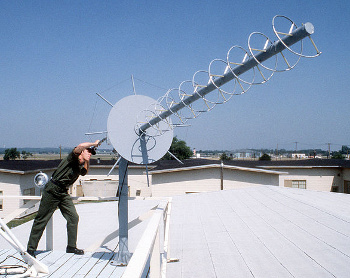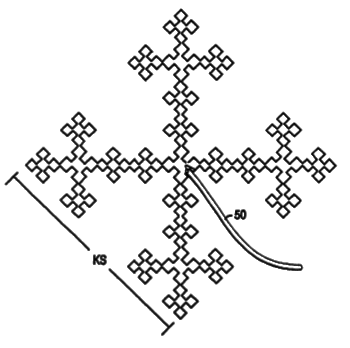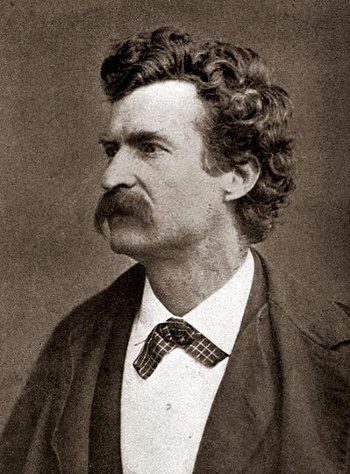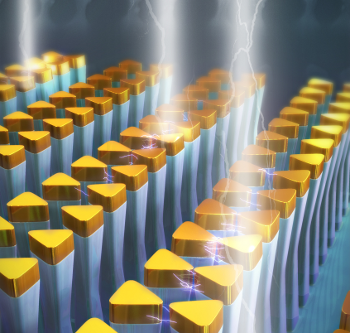Bowtie Nanoantennas
August 1, 2014
Antenna design is one of the more
creative parts of
radio frequency engineering. Although there's the
rule of thumb that an antenna's dimension should be of the order of its working
wavelength, it's often not
intuitive how
electric currents will be induced into shaped
conductors by
electromagnetic fields. Therefore,
computer modeling is now used to determine an antenna's
characteristic impedance and
radiation/
reception pattern.
One novel antenna, invented in the days before
computers, is the
axial mode (end fire) helical antenna. This antenna was invented in 1946 by
John Kraus (1910-2004). As Kraus wrote in his classic
textbook, "Antennas," he wound a
helix of seven turns of
copper wire with a 12
centimeter circumference, this being the wavelength of his
signal source. He detected a narrow beam with
circular polarization.[1] Helical antennas are now ubiquitous in many
high frequency applications, such as
satellite communication (see figure).

A satellite communications antenna pictured in 1984.
This is a typical helical antenna.
(US Air Force photograph by SSgt Louis Comeger, via Wikimedia Commons.)
A helix is a simple
geometrical object, so the possibility of its being a useful antenna was tested just a little more than a half
century after the first generation of radio waves in 1887 by
Heinrich Hertz. Thirty years after the helical antenna,
Benoit Mandelbrot popularized
fractals, so it was just a matter of time before
fractal antennas were designed and tested (see figure).[2]

Figure 7E of US Patent No. 6,452,553, "Fractal antennas and fractal resonators," by Nathan Cohen, September 17, 2002.
Engineers will notice the resemblance to a shorted twin-lead.
(Via Google Patents.)[2)]
One simple geometrical shape, the
triangle, is used as the basis for the
bowtie/batwing antenna. These antennas are useful for
broadcasting, especially
television broadcasting, since they emit in a nearly
omnidirectional pattern. When a stack of these are mounted with the plane of the antennas
perpendicular to the
ground, the signals are directed along the
Earth's surface where they are most useful.

A famous bowtie.
Photograph of Samuel Langhorne Clemens, better known as Mark Twain (1835-1910)
Twain, who was friends with Nikola Tesla, liked science, but he lost his fortune on investments in technology. Twain's 1889 novel, A Connecticut Yankee in King Arthur's Court, was based on time travel.
(Photograph from the 1922 book, "American Portraits," by Bradford, Gamaliel, via Wikimedia Commons.)
Engineers from the
University of Illinois at Urbana-Champaign (Urbana, Illinois) Department of Electrical and Computer Engineering, the
Micro and Nanotechnology Laboratory, and the
Department of Mechanical Science and Engineering have built novel arrays of
nanoscale bowtie antennas. The novelty is in the fact that the individual triangular elements of the bowtie are atop movable
pillars on a
silicon wafer.[3-4]
The elements of their so-called pillar-bowtie nanoantennas (p-BNA) sit atop 500-
nanometer tall
silicon dioxide pillars. The principal advantage of doing this is that the gap between the triangle sections of the bowtie can be made much smaller that the
lithographic process allows. The gap can be tuned to about 5 nm, which is about four times smaller than that obtained from
electron-beam lithography (see figure).[4]

Illustration of the University of Illinois bowtie nanoantenna array. The bowties are made of gold.
(University of Illinois Illustration.)
A
scanning electron microscope (SEM) was used to deform individual p-BNA structures, or groups of p-BNAs within a sub-array. The deformation rate was as large as 60 nanometers per second.[3-4] The mechanical actuation was facilitated by the relatively high 4.2
aspect ratio of the p-BNAs.[4] A
video of the actuation is available online.[5]
These
gold nanoantennas interact with light via
plasmons, so modification of the antenna gap modifies the
optical response. Says
Kimani Toussaint, an
associate professor of mechanical science and engineering at the University of Illinois and
leader of the
research project,
"For our approach, one can take a nanoarray structure that was already fabricated and further reconfigure the plasmonic, and hence, optical properties of select antennas. Therefore, one can decide after fabrication, rather than before, how they want their nanostructure to modify light."[4]
The research team envisions spatially addressable devices for particle manipulation and sensing.[4]
References:
- J.D. Kraus, "Antennas," McGraw-Hill (New York, 1988), pp. 265f. (2001 paperback edition, via Amazon.)
- Nathan Cohen, "Fractal antennas and fractal resonators," US Patent No. 6,452,553 , September 17, 2002.
- Brian J. Roxworthy, Abdul M. Bhuiya, Xin Yu, Edmond K. C. Chow, and Kimani C. Toussaint, Jr., "Reconfigurable nanoantennas using electron-beam manipulation," Nature Communications, vol. 5, Article no. 4427 (July 14, 2014), doi:10.1038/ncomms5427.
- Researchers demonstrate novel, tunable nanoantennas, University of Illinois Press Release, July 14, 2015.
- Video: Top view of the bowtie antenna deformation process using 450k magnification (Nature Web Site).
Permanent Link to this article
Linked Keywords: Antenna; creativity; creative; radio frequency; engineering; rule of thumb; wavelength; intuition; intuitive; electric current; electrical conductor; electromagnetic field; computer simulation; computer modeling; electrical impedance; characteristic impedance; electromagnetic radiation; reception; pattern; computer; axial mode (end fire) helical antenna; John Kraus (1910-2004); textbook; helix; copper wire; centimeter; circumference; signal source; circular polarization; radio spectrum; high frequency; satellite; communication; US Air Force; Staff sergeant; SSgt; Wikimedia Commons; geometry; geometrical; century; Heinrich Hertz; Benoit Mandelbrot; fractal; fractal antenna; twin-lead; Google Patents; triangle; bowtie antenna; batwing antenna; broadcasting; television; omnidirectional; perpendicular; ground; Earth's surface; Mark Twain (1835-1910); Nikola Tesla; science; investment; technology; novel; A Connecticut Yankee in King Arthur's Court; time travel; engineer; University of Illinois at Urbana-Champaign (Urbana, Illinois); Department of Electrical and Computer Engineering; Micro and Nanotechnology Laboratory; Department of Mechanical Science and Engineering; nanoscopic scale; nanoscale; column; pillar; silicon wafer; nanometer; silicon dioxide; photolithography; lithographic process; electron-beam lithography; gold; scanning electron microscope; aspect ratio; video; gold; plasmon; optics; optical; Kimani Toussaint; associate professor; leader; research; Nathan Cohen, "Fractal antennas and fractal resonators," US Patent No. 6,452,553, September 17, 2002.